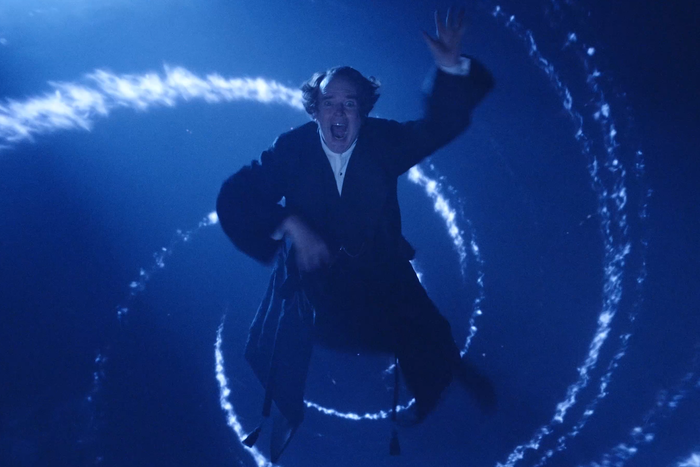
The first, most unsettling effect in this new A Christmas Carol is total darkness. Once the audience has settled in, peering at a black coffin through a gap in the curtains, director Michael Arden cuts the lights with an accompanying grand clang. It feels, for a second, like the power has failed. Then there’s the comfort of hearing a voice — Jefferson Mays, in a monologue describing the familiar resentments of Scrooge, carrying a candle across the stage, lighting a sconce or two, slowly drawing you in on the human scale.
A Christmas Carol, as conceived by Arden and scenic designer Diane Laffrey and adapted by Arden and Susan Lyons, weaves between the shock of spectacle like that sudden outage and the nimble close-up magic-like theatrics that Mays can accomplish on his own. He plays all the roles, from the jowly Scrooge to a tight-shouldered Tiny Tim, while also serving as the narrator. (It’s the mode of Carol-ing also performed by Patrick Stewart.) Arden and Laffrey often egg on the transformations with dramatic shifts in lighting (by Ben Stanton), but often that’s unnecessary. The spectacle of theatrical magic is less interesting than the spectacle Mays can conjure on his own.
All the Dickensian characters in the story seem to lie just under Mays’s skin, and they overtake him physically as the play progresses, his features shifting around his face for each persona like he’s his own Mr. Potato Head. He’s done multiple-character performances in this mode before, winning Tonys for I Am My Own Wife and A Gentleman’s Guide to Love and Murder, and seems to get more energized the greater the number of characters he plays per scene. His performance reaches its summit as he acts out the Cratchits’ Christmas dinner alone at a wooden table, fluttering among the various members of the family with such speed that they all seem to be in front of you, right there with the cheap goose. Fittingly, given the spooky scenes that precede the dinner, it’s a bit like watching ghosts inhabit a medium at a séance.
As for the actual ghosts of Christmas Past, Present, and Future, they loom over the production at magnified scale. This is a grimmer take on Dickens’s story, full of fog and shadows, than you may have seen told and retold elsewhere, and Arden has those shadows overwhelm the theater — in that blackout, in the unnerving bareness of Scrooge’s manor, and in the rendering of the Ghost of Christmas Future as an apparition via video trickery. Bring your children if you like, but prepare for them to squirm audibly in their seats, as some did when I saw the show. Arden brings Dickens’s social commentary into a high gothic realm, seeking out the dark evil lurking inside of the fable, stalking the streets of London, greed seeping out at you from the screens that line Laffrey’s set. When you leave the show and walk into Times Square, you wonder if it’ll come out at you from the billboards.
There’s a limit to what those screens can conjure, however, and A Christmas Carol falters when it relies more on them than Mays. He’s best with actual props in front of him — as with that table at the Cratchits’, or when he takes a hearty swig from a cup onstage and then offers it to an audience member in front of him — and the scaled-up effects work hard to do what he could accomplish with his own toolbox. While Scrooge revisits his past, Laffrey provides a glimpse at the revelry he’s missed via video footage of Londoners cavorting in their homes. It’s unnerving, after time spent with Mays’s troupe of one, to see other figures, and even blurred, the reality of that footage distracts from his storytelling. The same goes for the whirls of snow seen via the screens, or a psychedelic trip into the future in a Marvel-esque vortex, which can make the walls themselves seem less substantial. What you want is to be alone with Mays, to see what he can do just by telling you to imagine. We’re not here to watch TV.
This Christmas Carol is a product of the pandemic, starting out with a live filmed version in 2020 and then a run in Los Angeles last year. It has, like a lot of art touched by those circumstances, a loneliness to it. Alone on a large stage, encroached upon by projections and effects, Mays feels so far away from everything else, he may as well be behind a screen. It feels like a relief, then, when he plays to the audience, works them for laughs, gives everyone a feeling of being together in something. Scrooge’s life, before his transformation, is isolated too, as he’s forced himself apart from the teeming masses of London in his high dungeon of capital. The spirits scare him straight, but it’s the fact that he can welcome other people into his life that’s the real sign he’s changed. No more Zoom for him.
A Christmas Carol is at the Nederlander Theatre through January 1.


